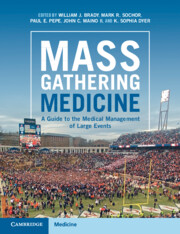278 results
Contributors
-
- Book:
- Mass Gathering Medicine
- Published online:
- 11 April 2024
- Print publication:
- 18 April 2024, pp ix-xii
-
- Chapter
- Export citation
Preface
-
- Book:
- Mass Gathering Medicine
- Published online:
- 11 April 2024
- Print publication:
- 18 April 2024, pp xv-xvi
-
- Chapter
- Export citation
Appendix 2 - Suggested Medications: Infield Medical Center
- from Chapter 13 - Mass Gathering Events: Motor Sport Events
-
- Book:
- Mass Gathering Medicine
- Published online:
- 11 April 2024
- Print publication:
- 18 April 2024, pp 195-195
-
- Chapter
- Export citation
Dedication
-
- Book:
- Mass Gathering Medicine
- Published online:
- 11 April 2024
- Print publication:
- 18 April 2024, pp v-vi
-
- Chapter
- Export citation
Appendix 3 - NASCAR Recommended Equipment for Infield Medical Center from NASCAR 2012 Medical Verification Form
- from Chapter 13 - Mass Gathering Events: Motor Sport Events
-
- Book:
- Mass Gathering Medicine
- Published online:
- 11 April 2024
- Print publication:
- 18 April 2024, pp 196-198
-
- Chapter
- Export citation
Appendix 1 - Motor-Sports Concussion Guidelines
- from Chapter 13 - Mass Gathering Events: Motor Sport Events
-
- Book:
- Mass Gathering Medicine
- Published online:
- 11 April 2024
- Print publication:
- 18 April 2024, pp 194-194
-
- Chapter
- Export citation
Foreword
-
- Book:
- Mass Gathering Medicine
- Published online:
- 11 April 2024
- Print publication:
- 18 April 2024, pp xiii-xiv
-
- Chapter
- Export citation
Index
-
- Book:
- Mass Gathering Medicine
- Published online:
- 11 April 2024
- Print publication:
- 18 April 2024, pp 406-418
-
- Chapter
- Export citation
Copyright page
-
- Book:
- Mass Gathering Medicine
- Published online:
- 11 April 2024
- Print publication:
- 18 April 2024, pp iv-iv
-
- Chapter
- Export citation
Contents
-
- Book:
- Mass Gathering Medicine
- Published online:
- 11 April 2024
- Print publication:
- 18 April 2024, pp vii-viii
-
- Chapter
- Export citation

Mass Gathering Medicine
- A Guide to the Medical Management of Large Events
-
- Published online:
- 11 April 2024
- Print publication:
- 18 April 2024
Head and Neck Cancer: United Kingdom National Multidisciplinary Guidelines, Sixth Edition
-
- Journal:
- The Journal of Laryngology & Otology / Volume 138 / Issue S1 / April 2024
- Published online by Cambridge University Press:
- 14 March 2024, pp. S1-S224
- Print publication:
- April 2024
-
- Article
-
- You have access
- Open access
- HTML
- Export citation
Agricultural Research Service Weed Science Research: Past, Present, and Future
-
- Journal:
- Weed Science / Volume 71 / Issue 4 / July 2023
- Published online by Cambridge University Press:
- 16 August 2023, pp. 312-327
-
- Article
-
- You have access
- Open access
- HTML
- Export citation
Characterising small objects in the regime between the eddy current model and wave propagation
- Part of
-
- Journal:
- European Journal of Applied Mathematics / Volume 35 / Issue 2 / April 2024
- Published online by Cambridge University Press:
- 08 August 2023, pp. 294-317
-
- Article
-
- You have access
- Open access
- HTML
- Export citation
Efficacy and safety of a 4-week course of repeated subcutaneous ketamine injections for treatment-resistant depression (KADS study): randomised double-blind active-controlled trial
-
- Journal:
- The British Journal of Psychiatry / Volume 223 / Issue 6 / December 2023
- Published online by Cambridge University Press:
- 14 July 2023, pp. 533-541
- Print publication:
- December 2023
-
- Article
-
- You have access
- Open access
- HTML
- Export citation
Basal debris of the NEEM ice core, Greenland: a window into sub-ice-sheet geology, basal ice processes and ice-sheet oscillations
-
- Journal:
- Journal of Glaciology / Volume 69 / Issue 276 / August 2023
- Published online by Cambridge University Press:
- 17 May 2023, pp. 1011-1029
-
- Article
-
- You have access
- Open access
- HTML
- Export citation
Cost consequence analysis of Apathy in Dementia Methylphenidate Trial 2 (ADMET 2)
-
- Journal:
- International Psychogeriatrics / Volume 35 / Issue 11 / November 2023
- Published online by Cambridge University Press:
- 17 April 2023, pp. 664-672
-
- Article
-
- You have access
- Open access
- HTML
- Export citation
Epidemiology and genomics of a slow outbreak of methicillin-resistant Staphyloccus aureus (MRSA) in a neonatal intensive care unit: Successful chronic decolonization of MRSA-positive healthcare personnel
-
- Journal:
- Infection Control & Hospital Epidemiology / Volume 44 / Issue 4 / April 2023
- Published online by Cambridge University Press:
- 16 June 2022, pp. 589-596
- Print publication:
- April 2023
-
- Article
- Export citation
Canadian Stroke Best Practice Recommendations: Secondary Prevention of Stroke Update 2020 – ADDENDUM
-
- Journal:
- Canadian Journal of Neurological Sciences / Volume 50 / Issue 3 / May 2023
- Published online by Cambridge University Press:
- 03 June 2022, p. 481
-
- Article
-
- You have access
- Open access
- HTML
- Export citation
Appendix: Summary of Key Peace Agreements
-
- Book:
- Lawyering Peace
- Published online:
- 27 September 2021
- Print publication:
- 16 December 2021, pp 197-236
-
- Chapter
- Export citation

